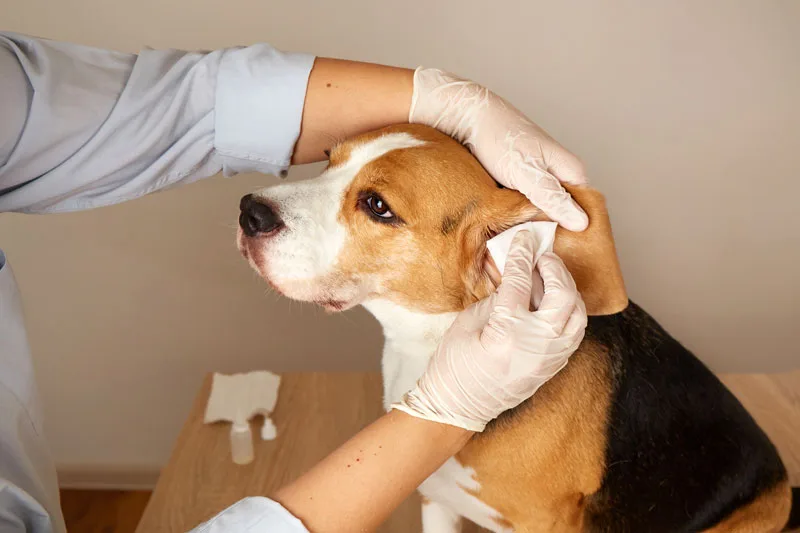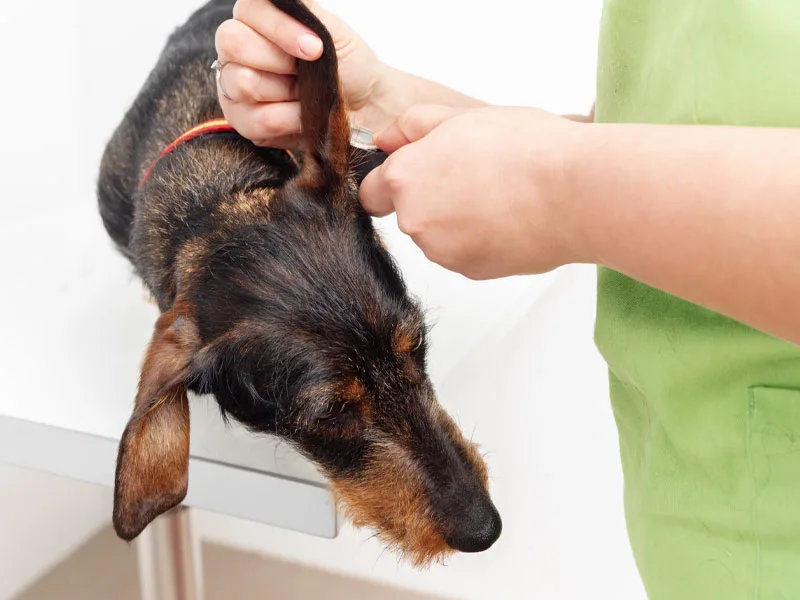Dog Ear Infection Troubles? My Step-by-Step Fix

I never thought I’d be Googling “why does my dog’s ear smell so bad?” at 2 AM, but there I was, half-asleep, with my pup Max shaking his head like he was trying to fling something out of his ear. The poor guy had been scratching at his ear for days, and I figured it was just a little itch. But then came the smell—a funky, almost yeasty odor that made me realize something was definitely wrong.
As a pet parent, seeing your dog in discomfort is heartbreaking. At first, I tried to clean his ear with a cotton ball, thinking it was just some dirt buildup. But Max yelped in pain, and I knew this was more than just a little wax problem. After a trip to the vet and some research, I learned that ear infections in dogs are incredibly common—especially in breeds with floppy ears like Labradors, Cocker Spaniels, and Basset Hounds.
If your dog is constantly shaking their head, scratching their ears, or has an unpleasant smell coming from their ear, they could have an ear infection. In this guide, I’ll walk you through the causes, symptoms, and step-by-step instructions on how to help your dog at home, as well as when to seek veterinary care.
Possible Causes of Ear Infections in Dogs
Dogs can develop ear infections for many reasons, and understanding the cause is the first step in treating the problem effectively. Here are the most common culprits:
- Bacteria & Yeast Overgrowth – Dogs have naturally occurring bacteria and yeast in their ears. When the ear environment becomes too moist or inflamed, these microorganisms multiply excessively, leading to an infection.
- Ear Mites – These tiny parasites are more common in puppies and can cause intense itching, dark discharge, and inflammation. If left untreated, mites can cause severe irritation and secondary infections.
- Allergies – Dogs with food allergies or environmental allergies (like pollen, dust, or grass) often suffer from chronic ear infections. Allergies cause inflammation, which can lead to a breeding ground for bacteria and yeast.
- Excess Moisture (Swimmer’s Ear) – If your dog loves swimming or bathing, excess water in the ears can create a warm, damp environment perfect for bacteria to thrive.
- Wax Buildup & Poor Ear Hygiene – Some dogs naturally produce more ear wax than others. If wax accumulates, it can trap dirt and bacteria, leading to an infection.
- Foreign Objects (Grass Seeds, Debris, etc.) – Dogs that love rolling in the grass or digging in the dirt might get small objects like grass seeds or sand lodged in their ears, causing irritation and infection.
- Underlying Health Conditions – Some medical conditions, like hormonal imbalances (hypothyroidism) or autoimmune diseases, can make a dog more prone to recurring ear infections.
Understanding the root cause of your dog’s ear infection is crucial to preventing future occurrences. Now, let’s talk about what you should do when your dog has an ear infection.
Step-by-Step Guide on What to Do
1. Identify the Symptoms
If your dog has an ear infection, they may show one or more of these signs:
✔️ Frequent head shaking or tilting
✔️ Constant scratching at the ears
✔️ Foul smell coming from the ear
✔️ Redness or swelling inside the ear
✔️ Dark brown, yellow, or pus-like discharge
✔️ Crusting or scabbing around the ear
✔️ Pain or sensitivity when you touch their ear
✔️ Loss of balance or unusual eye movements (in severe cases)
If you notice multiple symptoms, your dog likely has an ear infection, and you should act quickly to provide relief.
2. Inspect Your Dog’s Ear Safely
Before doing anything, gently inspect your dog’s ear to see what’s going on. Here’s how to do it without causing more discomfort:
🔎 Step 1: Sit in a quiet area and gently position your dog so they are calm and comfortable.
🔎 Step 2: Lift their ear flap and look inside. If the ear is very red, swollen, or has thick discharge, an infection is likely present.
🔎 Step 3: Smell the ear—a strong, yeasty, or foul odor is a big red flag.
🔎 Step 4: Check for debris or parasites—tiny white specks moving around may indicate ear mites.
🔎 Step 5: If your dog yelps or pulls away, the infection may be too painful for home treatment, and it’s best to call the vet.
3. Clean the Ear Properly
If the infection is mild and caught early, you may be able to clean the ear and prevent it from getting worse. Here’s how to do it safely:
🧴 Step 1: Get a vet-approved ear cleaner (avoid alcohol-based or hydrogen peroxide, as they can irritate the ear).
🧴 Step 2: Soak a cotton ball with the cleaner (never use Q-tips—they can push debris further into the ear).
🧴 Step 3: Gently wipe the outer ear canal and remove any visible wax or debris.
🧴 Step 4: Squeeze a few drops of ear-cleaning solution into the ear canal and massage the base of the ear for 30 seconds.
🧴 Step 5: Let your dog shake their head to remove excess liquid, then wipe the outer ear dry.
If the ear looks very inflamed, has pus, or is extremely painful, stop immediately and contact a vet.
4. Reduce Moisture & Bacteria Buildup
🐶 After swimming or baths, always dry your dog’s ears thoroughly with a soft towel.
🐶 Use vet-approved ear-drying drops if your dog is prone to moisture-related infections.
🐶 Avoid overcleaning—cleaning too often can irritate the ear and strip away protective oils.
5. Try Home Remedies with Caution
Some natural remedies can help with mild ear irritation, but they should never replace proper treatment. If the infection is severe, home remedies won’t be enough.
SAFE HOME REMEDIES (for mild cases only):
✔️ Diluted apple cider vinegar (50/50 with water) – Helps kill bacteria but should not be used if the ear is inflamed or has open sores.
✔️ Coconut oil – Has natural antibacterial properties; apply a tiny amount inside the ear.
✔️ Oregano oil (diluted with carrier oil) – Has antifungal properties but must be used sparingly.
⚠️ DO NOT use: hydrogen peroxide, essential oils, or alcohol-based solutions, as they can burn sensitive ear tissue.
When to Contact a Veterinarian
Seek veterinary care if:
🚨 The infection worsens or doesn’t improve within 2-3 days.
🚨 There is thick pus-like discharge or bleeding.
🚨 Your dog is in visible pain or yelping.
🚨 You suspect ear mites or a foreign object in the ear.
🚨 Your dog loses balance or seems dizzy.
A vet may prescribe antibiotics, antifungal medications, or medicated ear drops to treat severe infections.
Final Thoughts
Ear infections are painful and frustrating for dogs, but early detection and proper care can prevent them from becoming serious. If your dog frequently gets ear infections, talk to your vet about underlying allergies or preventive treatments.
If your pup’s infection isn’t improving or they seem really uncomfortable, always take them to the vet—it’s better to be safe than sorry! Your dog will thank you with wagging tails and happy ears once they’re feeling better! 🐶💛

Worried About Your Pet's Health? Schedule a Checkup!
Don't wait until it's too late. Our compassionate team is dedicated to providing top-notch care. Schedule your pet's checkup today and ensure their well-being.
BOOK A PET CHECKUP
